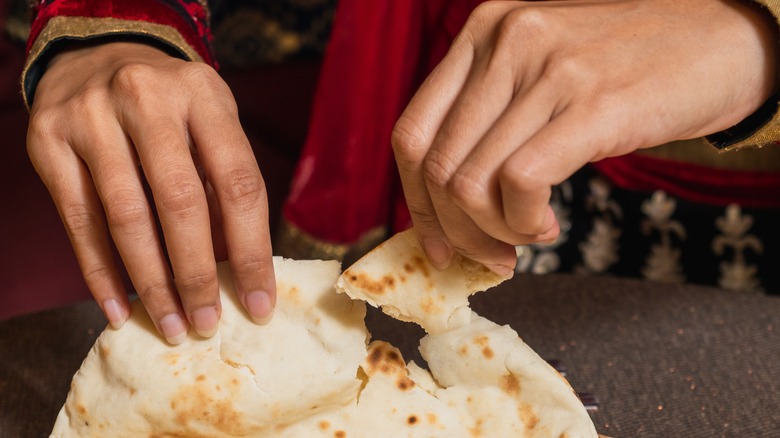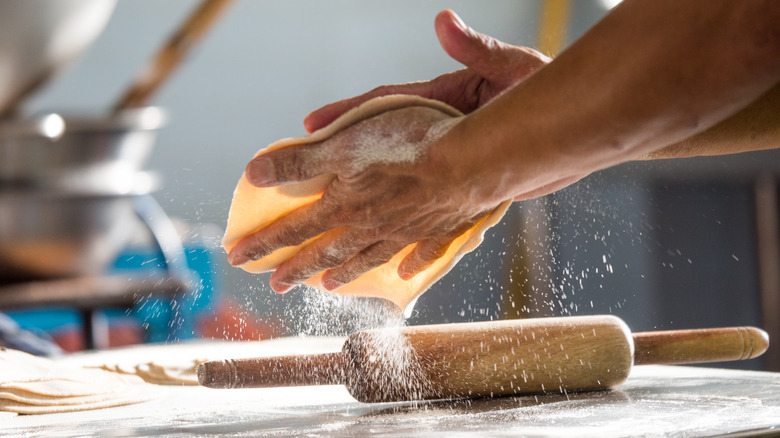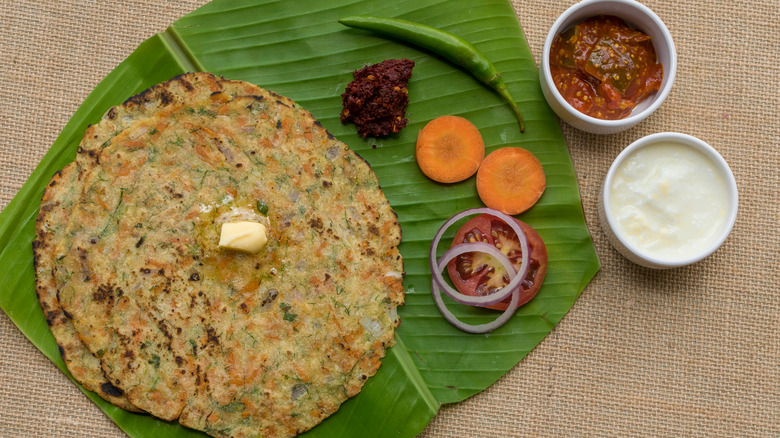North Indian Roti Vs. South Indian: What's The Difference?
With 1.4 billion people living in India, per Pew Research Center, dozens of bread varieties touch the heartstrings of Indians and compete for prominence as the country's favorite. Many of the top contenders come in the form of unleavened flatbreads, generally falling under the comprehensive umbrella of "roti," according to The Times of India. Roti can vary by region, with different types of flour, cooking methods, and added ingredients such as spices and vegetables used in the recipes.
Wheat flour forms the basis of many roti bread recipes, but some regions incorporate other flour varieties. New Delhi Television explains roti can also be made with rice flour, ragi millets, lentil flour, and even bajra — a grain Healthline describes is made from seeds of pearl millet plants.
Roti incarnations parade across home kitchens, cafes, and street-food stands on a daily basis, forming the heart of many Indian dinner recipes. Here's a look at some of the most commonly eaten roti breads in North and South India.
Roti breads from North India
By far, the most noted roti bread in North India is a flatbread recipe known as chapati, a doughy disk created from whole wheat four. The name comes from the Hindi word meaning "to slap," a reference to the way chefs prepare chapati: by slapping dough between two hands before frying it on a thin, flat tawa pan (per Michelin Guide).
Hailing from Rajasthan, missi roti holds similarities to chapati, with the addition of spices such as cumin, turmeric, and red chili powder. Poori, or Puri, roti breads cooked crispy golden-brown, are puffier pieces of bread that have been rolled and deep fried, explains New Delhi Television. In the Punjabi region of North India, makki roti also sizzles on tawa pans. This type of roti uses corn flour or maize and is eaten alongside a spicy curry known as sarson ka saag (via The Times of India).
South Indian roti breads
South Indian cuisine tends to lean toward fresh fruits, vegetables, and seafood rather than meat and dairy products, explains Sukhi's Indian Cuisine. Most dishes are spicy, utilizing concoctions like sambar powder and cardamom, nutmeg, cinnamon, and mustard seeds. This culinary mentality stretches to roti bread recipes as well.
Akki roti from the Karnataka region of southwestern India takes its name from akki, the word meaning rice. These roti renditions feature rice flour infused with grated vegetables and spices, per The Times of India. Akki roti also goes by the name of pathiri roti in the South Indian state of Kerala. Another well-loved bread is ragi roti, which differs from other flatbreads in that it comes stuffed with chilies, onions, and vegetables (via New Delhi Television).
Though other types of roti bread abound, here's a final nod to a local South Indian favorite: Originating in Tamil Nadu, Kerala, and possibly Chennai, parotta roti, a flatbread made with maida flour, complements breakfast and lunch meals, especially when served with dal lentil curries (per Michelin Guide). Because of a higher-than-normal percentage of gluten, this roti is doughier and smoother than other bread types, lending to modern Indian cuisine and dishes with sweetened condensed milk.


